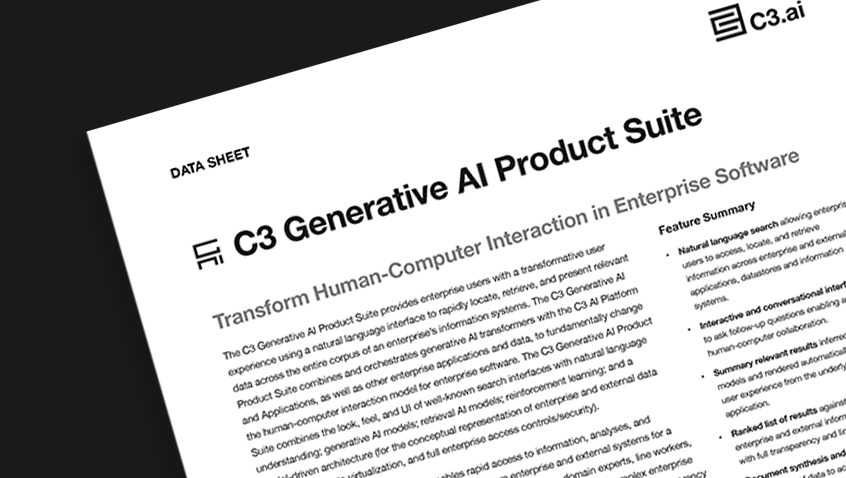- AI Software
- C3 AI Applications
- C3 AI Applications Overview
- C3 AI Anti-Money Laundering
- C3 AI Cash Management
- C3 AI Contested Logistics
- C3 AI CRM
- C3 AI Decision Advantage
- C3 AI Demand Forecasting
- C3 AI Energy Management
- C3 AI ESG
- C3 AI Health
- C3 AI Intelligence Analysis
- C3 AI Inventory Optimization
- C3 AI Process Optimization
- C3 AI Production Schedule Optimization
- C3 AI Property Appraisal
- C3 AI Readiness
- C3 AI Reliability
- C3 AI Smart Lending
- C3 AI Sourcing Optimization
- C3 AI Supply Network Risk
- C3 AI Turnaround Optimization
- C3 Generative AI Constituent Services
- C3 Law Enforcement
- C3 Agentic AI Platform
- C3 Generative AI
- Get Started with a C3 AI Pilot
- Industries
- Customers
- Events
- Resources
- Generative AI for Business
- Generative AI for Business
- C3 Generative AI: How Is It Unique?
- Reimagining the Enterprise with AI
- What To Consider When Using Generative AI
- Why Generative AI Is ‘Like the Internet Circa 1996’
- Can the Generative AI Hallucination Problem be Overcome?
- Transforming Healthcare Operations with Generative AI
- Data Avalanche to Strategic Advantage: Generative AI in Supply Chains
- Supply Chains for a Dangerous World: ‘Flexible, Resilient, Powered by AI’
- LLMs Pose Major Security Risks, Serving As ‘Attack Vectors’
- What Is Enterprise AI?
- Machine Learning
- Introduction
- What is Machine Learning?
- Tuning a Machine Learning Model
- Evaluating Model Performance
- Runtimes and Compute Requirements
- Selecting the Right AI/ML Problems
- Best Practices in Prototyping
- Best Practices in Ongoing Operations
- Building a Strong Team
- About the Author
- References
- Download eBook
- All Resources
- Publications
- Customer Viewpoints
- Blog
- Glossary
- Developer Portal
- Generative AI for Business
- News
- Company
- Contact Us
- Generative AI for Business
- C3 Generative AI: How Is It Unique?
- Reimagining the Enterprise with AI
- What To Consider When Using Generative AI
- Why Generative AI Is ‘Like the Internet Circa 1996’
- Can the Generative AI Hallucination Problem be Overcome?
- Transforming Healthcare Operations with Generative AI
- Data Avalanche to Strategic Advantage: Generative AI in Supply Chains
- Supply Chains for a Dangerous World: ‘Flexible, Resilient, Powered by AI’
- LLMs Pose Major Security Risks, Serving As ‘Attack Vectors’
- C3 Generative AI: Getting the Most Out of Enterprise Data
- The Key to Generative AI Adoption: ‘Trusted, Reliable, Safe Answers’
- Generative AI in Healthcare: The Opportunity for Medical Device Manufacturers
- Generative AI in Healthcare: The End of Administrative Burdens for Workers
- Generative AI for the Department of Defense: The Power of Instant Insights
Generative AI in Healthcare: The End of Administrative Burdens for Workers
January 5, 2024
Ask most any doctor or healthcare provider the most taxing part of their profession and you’ll likely get the same answer: dealing with administrative work. Insurance companies. Record keeping. Note taking. You name it. We’ve all heard the complaints.
Now comes generative AI, likely the greatest productivity tool in generations, and the opportunity to quickly improve the most mundane parts of the healthcare system are obvious. Generative AI is poised to reshape and eliminate the burdensome administrative work that leads to doctor and nurse burnout while eating into the quality-of-care. One frequently cited study on the topic of administrative burdens in healthcare found that primary care physicians spend more than half their day updating electronic patient charts.
Multiple medical associations, from the American College of Physicians to American Physical Therapy Association and the American College of Obstetrics and Gynecologists, have initiatives to make policy changes to ease administrative burdens — all of which would include a role for new technology. Letting generative AI take on the lion’s share of work in patient note taking, chart upkeep, and answering patient portal questions — becoming, in effect, a smart office assistant who take notes and generate summaries — will alleviate staff workload and, in time, refocus daily work on patients themselves.
Standardized Patient Notes and Better Data
Let’s start with the basics. Physicians and support staff, for instance, can use generative AI to write detailed clinical notes and care summaries. If software can initiate and draft patient charts, then physicians can simply review for accuracy. Since medical scribes — a documentation specialist who follows a doctor to take notes and keep patient charts — have been shown to improve physician productivity, then generative AI can do the same. And do it faster, cheaper, and without getting burned out.
Using AI to generate charts would save thousands of working hours. Plus, adoption across providers could lead to widespread patient chart standardization. That has greater industry implications, including improving healthcare datasets for research and communication between providers across institutions and specialties.
Chart standardization in itself is a compelling argument for adapting generative AI, leading to better recordkeeping across the entire healthcare system. There are additional benefits, including more comprehensive and efficient multi-provider care and more robust datasets for medical research.
Care pathway management, which falls under the umbrella of multi-provider care, will also improve. A multidisciplinary approach, a care pathway is a set of clinical plans mapped for a specific population of patients. Physicians use evidence-based research to design a standard set of recommendations that can then be personalized into a patient-specific care plan. For example, the World Health Organization developed a standard care pathway for physicians to treat COVID-19 that outlines four steps providers should take to ensure consistent and high-quality care.
This type of healthcare requires immense cooperation and communication between specialists, the patient, and sometimes the patient’s family. Using generative AI for physician notes — especially when standardized — makes it easier for doctors to treat patients coming from separate offices and gives physicians more time to develop these types of comprehensive pathway plans.
Aside from care pathways, a person doesn’t and can’t receive all their care from one physician and one healthcare system — so with a standardized note system, physicians would have an easier time picking up from a previous physician’s care.
Adopting generative AI for charting in healthcare can help alleviate patient concerns about being dismissed by their physicians when they bring up valid concerns. Many patients complain that their healthcare providers do not thoroughly investigate an issue because of bias based on anything from weight to gender to education, and sometimes the culprit is simply how little time a physician has to spend with their patient. Ensuring patients receive the same documentation would improve equity across the system; if doctors are required to cover a specific set of questions and follow ups, it stands to reason that fewer patients would be left wanting when it comes to their healthcare.
Generative AI in Healthcare: Image Analysis & Enhancement
In recent years, AI has been rightfully lauded as a way to assist healthcare workers with image and data analysis. Countless studies show how AI can save time by prioritizing and alerting radiologists to review high risk mammograms or X-rays with just as much accuracy as a human. With generative AI, physicians can improve medical imaging practices even further. Using this newer technology to enhance images helps avoid repeated tests or assessments — saving the entire system time and money.
Image enhancement with generative AI means anything from sharpening a blurry image, image segmentation, or image reconstruction. Doctors continue to stay in the loop — they would be the ones asking for an enhanced image. But using AI to clean up a film takes minutes versus requesting a patient re-take a test could delay a diagnosis by days or even weeks.
Generative AI could also be used to create labels on medical images, annotating films in a similar way it could be used to write patient charts. Radiologists could cut down on the number of hours they spend creating these detailed notes, especially for patients who have no disease or injury markers. In addition, these AI models could, in the future, also provide disease progression predictions or surgical plans.
Minimizing the Workload from Patient Portals
With online portals, patients and healthcare workers have both benefitted, but they have also created a new workload — checking and responding to patient questions online. One study even showed that time spent responding to portal questions and updating electronic health records contribute to higher physician burnout rates. And many times, physicians and nurses providing care do not want to provide health recommendations or advice through a portal without examining a patient, but this doesn’t stop patients from asking those types of questions.
Generative AI could take over responding to questions that are not about a diagnosis or providing medical advice — lifting some of the burden from staff. These types of tools could also answer questions about the healthcare system or provide general counseling similar to what people can find online, but with generative AI, the answers could be slightly more tailored to their specific situations.
For example, say a patient wants to clear a new physical activity with their doctor because of a recent arthritis diagnosis. And when searching for a quick answer online, they keep finding conflicting medical advice based on disease progression, age, sex, and more. With a generative AI–enabled portal, this patient could ask their question and the AI chatbot could respond in a way that takes their medical history into consideration — a much more efficient process for both the healthcare system and the patient.
Where to Start
These examples are just the starting point when it comes to what generative AI could do for healthcare. Alleviating physician and healthcare worker burnout is a current priority as set by the U.S. Surgeon General for the U.S. Department of Health and Human Services — and generative AI is a faster solution than increasing staff or implementing systemic changes.
An easy proof point that could allow for greater adoption of generative AI across departments and specialties could be using it to perform tasks such as summarizing research findings and operational reports. This would not only serve as an example for proving usefulness, but also as a way to show how using AI is about enhancing healthcare workers’ productivity, not replacing them with technology.
This article was written by Liz Sheeley, a former science and engineering writer who is now C3 AI’s Lead Communications Writer.



